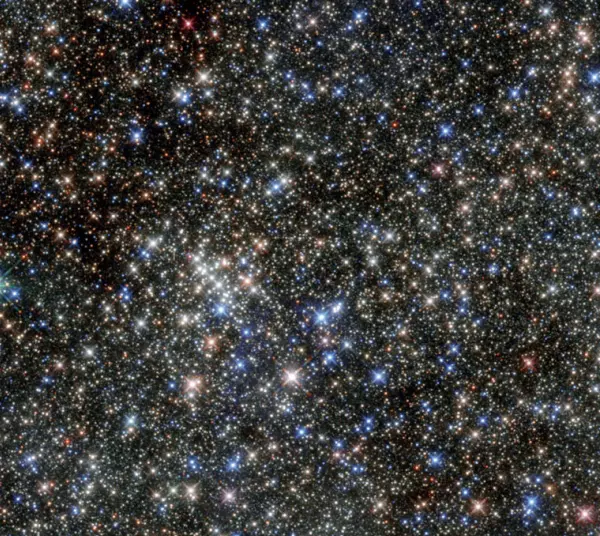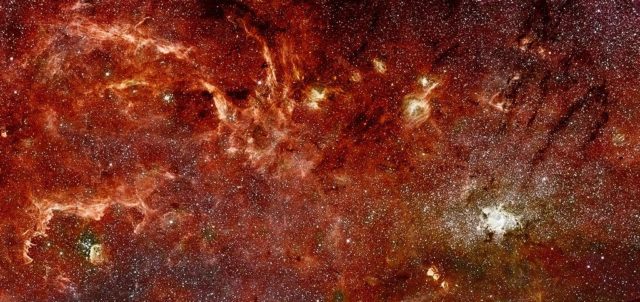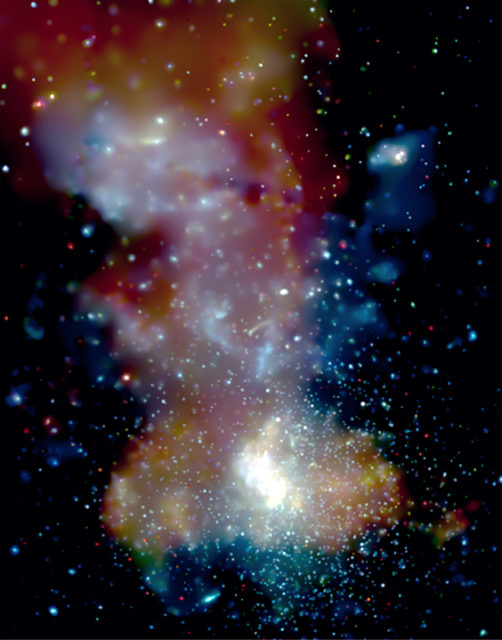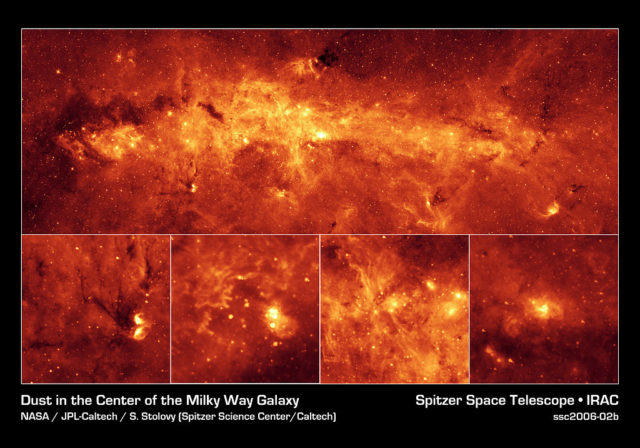The Quintuplet Cluster is a dense open cluster located at a distance of 26,000 light years from Earth in the direction of Sagittarius constellation and only about 100 light years from the Galactic centre.
Like the nearby Arches Cluster, it cannot be observed visually because it is obscured by dust clouds, but must be studied in infrared, radio and X-ray wavelengths. The cluster is located 12 arc minutes to the northwest of Sagittarius A*.
The Quintuplet Cluster was named for the five prominent infrared sources that it contains. The cluster was first detected in 1983 as a pair of infrared sources, which were designated GCS-3 and GCS-4 (Galactic Centre Source 3 and 4). GCS-3 was later resolved into four separate sources that, together with GCS-4, formed a quintuplet. The cluster itself was discovered in 1990, when infrared observations allowed researchers to see it through the obscuring dust near the Galactic centre. The objects were believed to be hot, luminous young stars. The first five stars discovered, still believed to be protostars, were labelled Q1, Q2, Q3, Q4 and Q9. The stars Q5 and Q6 were later identified as members of the same cluster.

The Quintuplet Cluster hosts two exceptionally rare luminous blue variable stars: the Pistol Star and the lesser known V4650 Sgr. If you were to draw a line horizontally through the centre of this image from left to right, you could see the Pistol Star hovering just above the line about one third of the way along it. The Pistol Star is one of the most luminous known stars in the Milky Way and takes its name from the shape of the Pistol Nebula that it illuminates, but which is not visible in this infrared image. The exact age and future of the Pistol Star are uncertain, but it is expected to end in a supernova or even a hypernova in one to three million years. The cluster also contains a number of red supergiants. These stars are among the largest in the galaxy and are burning their fuel at an incredible speed, meaning they will have a very short lifetime. Their presence suggests an average cluster age of nearly four million years. At the moment these stars are on the verge of going out as supernovae. During their spectacular ends they will release vast amounts of energy which, in turn, will heat the material — dust and gas — between the other stars. This observation shows the Quintuplet Cluster in the infrared and demonstrates the leap in Hubble’s performance since its 1999 image of same object. Image: ESA/Hubble & NASA, 2015
Observations in 1994 indicated that the stars were more evolved than originally believed. Researchers discovered broad helium emission lines in the stars’ spectra. Two of the stars were classified as Wolf-Rayet stars, one as a luminous blue variable (which was thought to be one of the most luminous stars in the Milky Way at the time), and several were identified as red supergiants. The supergiants are some of the largest stars in the Milky Way and are expected to go through their supply of fuel quickly and have a very short lifetime.

The Galactic core is obscured in visible light by intervening dust clouds, but infra-red light penetrates the dust. NICMOS shows a large number of these massive stars distributed throughout the region. A new finding is that astronomers now see that the massive stars are not confined to one of the three known clusters of massive stars in the Galactic Centre, known as the Central cluster, the Arches cluster, and the Quintuplet cluster. These three clusters are easily seen as tight concentrations of bright, massive stars in the NICMOS image. The distributed stars may have formed in isolation, or they may have originated in clusters that have been disrupted by strong gravitational tidal forces. The winds and radiation from these stars form the complex structures seen in the core, and in some cases, they may be triggering new generations of stars. Image – Hubble: NASA, ESA, and Q.D. Wang (University of Massachusetts, Amherst); Spitzer: NASA, Jet Propulsion Laboratory, and S. Stolovy (Spitzer Science Center/Caltech)
A study of almost 600 stars in the cluster conducted in 1999 revealed that the Quintuplet had another luminous blue variable, as well as more Wolf-Rayet stars than any other cluster discovered to date.
The Quintuplet Cluster is less dense than the Arches Cluster and contains fewer exceptionally massive and luminous stars. It is also slightly older than its neighbour, as indicated by the number of red supergiants in the cluster. The Quintuplet has an estimated age of 4 million years.
Stars
The most luminous star in the cluster is WR 102hb, a Wolf-Rayet star with a magnitude of 9.6, temperature of 25,100 K, and luminosity 2,600,000 times that of the Sun. WR 102ea, the second most luminous star, has the same surface temperature, a luminosity 2,500,000 times solar and an apparent magnitude of 8.8.
The Quintuplet Cluster is home to several luminous blue variables (LBV), including the famous Pistol Star and the less well-known V4650 Sagittarii (qF362). These stars are expected to end their lives in supernova events within the next 3 million years. They are among the most luminous stars known.

Hubble Space Telescope image of the Quintuplet Cluster region. The Pistol Star is seen in the middle, surrounded by its ejection nebula. The luminous blue variable (LBV) star G0.120−0.048 is at the upper right, surrounded by a spherical nebula, believed to have been ejected by that star. LBV qF362 to the left of the Pistol Star also seems to be surrounded by a low-level nebular emission. Image: NASA/ESA, Hubble
The Pistol Star has a luminosity of 1,600,000 Suns and V4650 Sgr, of 1,800,000 Suns. The runaway star V4998 Sagittarii is also a luminous blue variable, positioned about 23 light years away from the cluster. The star is surrounded by an ejection nebula more than 0.8 parsecs in diameter and has a luminosity about 4,000,000 times that of the Sun.

The clusters, Arches (upper right), Quintuplet (upper center), and the GC cluster (bottom center), contain massive stars that appear as very bright, point-like X-ray sources when winds from their surfaces collide with those from an orbiting companion. Vast amounts of energy are also released when these stars go out as supernovas, heating the surrounding material. Stellar corpses in this image also emit X-rays as either neutron stars or black holes in binary systems. Collisions between the clusters themselves and cooler molecular clouds of gas contribute to the diffuse X-rays seen in this image. Image: Chandra X-ray Observatory. NASA/CXC/UMass Amherst/Q.D.Wang et al. Smithsonian Institution @ Flickr Commons
The Quintuplet Cluster is associated with the Sickle Nebula, an H II region that resembles the Pillars of Creation in Messier 16 (Eagle Nebula).
Named for its arc-like appearance, the Sickle Nebula contains fingers of ionized gas that are illuminated by the exceptionally hot stars in the cluster. The fingers are shaped by the strong stellar winds and radiation from the massive stars.
The Quintuplet Cluster is believed to be physically associated with the Galactic centre because the stars and other objects, including the Pistol Nebula, have large radial velocities, likely as a result of orbiting so close to the Milky Way centre.
The cluster will be torn apart by the gravitational tidal forces in the galaxy’s core in a few million years.
Quintuplet Cluster
Constellation: Sagittarius
Right ascension: 17h 46m 13.9s
Declination: −28° 49′ 48″
Apparent size: 50”
Distance: 26,000 light years (8,000 parsecs)
Mass: 10,000 solar masses
Age: 4 million years
Designations: Quintuplet Cluster, IRAS 17430-2848, G000.16-00.06

Our Milky Way is a dusty place. So dusty, in fact, that we cannot see the center of the galaxy in visible light. But when NASA’s Spitzer Space Telescope set its infrared eyes on the galactic center, it captured this spectacular view. Taken with just one of Spitzer’s cameras (at a wavelength of 8 microns), the image highlights the region’s exceptionally bright and dusty clouds, lit up by young massive stars. Individual stars can also be seen as tiny dots scattered throughout the dust. The top mosaic shows a portion of the galactic center that stretches across a distance of 760 light-years. Thanks to Spitzer’s excellent resolution, the dusty features within the galactic center are seen in unprecedented detail. Four examples are shown in the magnified insets at the bottom. The farthest left box shows a pair of star-forming regions resembling owl-like cosmic eyes. To the left of the “eyes,” dark lanes of dust can be seen. This object is probably located in a spiral arm between Earth and the galactic center, in contrast to the following examples, which are all located at the galactic center. The next inset to the right includes the exceptionally luminous “Quintuplet” stars, a set of five massive stars believed to have buried themselves in cocoons of dust. Just below and to the right of the Quintuplet is the “Pistol” nebula, a bubble of ejected material from the central, massive Pistol star. The finger-like pillars to the left are part of a structure known as “Sickle.” They are similar in size and shape to those in the famous picture of the Eagle Nebula taken by NASA’s Hubble Space Telescope. Pillars like these are sculpted out of dense dust clouds by radiation and winds from hot stars. The pillars in the Sickle were likely to have been formed by a cluster of hot stars located to their right but not readily visible here. The third inset highlights a system of long, stringy structures that are seen for the first time near the base of a region known as the “Arched Filaments.” These long filaments are about 10 light-years long and less than 1 light-year wide. The bright star-forming regions to the right are some of the brightest in the infrared sky. The final inset to the right shows the center of our galaxy, which is the brightest spot in the entire mosaic. The brightness is a result of dust being heated up by a compact cluster of hot stars. The bright spot also marks the location of a supermassive black hole, around which a rotating ring of gas and dust known as the circumnuclear disk can be seen. This image was taken with Spitzer’s Infrared Array Camera (IRAC), using its 8-micron detector. It shows emissions from heated-up molecules in dust clouds called polycyclic aromatic hydrocarbons. Image: NASA/JPL-Caltech/S. Stolovy (SSC/Caltech)